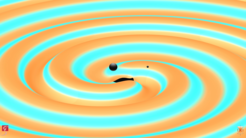New high-performance computing cluster at the Albert Einstein Institute in Potsdam
“Minerva” will calculate gravitational waves faster than the institute’s previous supercomputer
The new supercomputer “Minerva” has been put into operation at the Max Planck Institute for Gravitational Physics (Albert Einstein Institute, AEI). With 9,504 compute cores, 38 TeraByte memory and a peak performance of 302.4 TeraFlop/s it is more than six times as powerful as its predecessor. The scientists of the department “Astrophysical and Cosmological Relativity” can now compute significantly more gravitational waveforms and also carry out more complex simulations.
Minerva is to solve Einstein’s equations

Above all, the new computer cluster – named after the Roman goddess of wisdom – is used for the calculation of gravitational waveforms. These ripples in space time – measured for the first time directly in September 2015 – originate when massive objects such as black holes and neutron stars merge. Obtaining the exact forms of the emitted gravitational waves requires numerically solving Einstein’s complicated, non-linear field equations on supercomputers like Minerva. The AEI has been at the forefront of this field for many years and its researchers have been making important contributions to the software tools of the trade.
Tracking down faint signals in the detectors’ background noise and inferring information about astrophysical and cosmological properties of their sources requires calculating the mergers of many different binary systems such as binary black holes or pairs of a neutron star and a black hole, with different combinations of mass ratios and individual spins.
“Such calculations need a lot of compute power and are very time-consuming. The simulation of the first gravitational wave measured by LIGO lasted three weeks – on our previous supercomputer Datura,” says AEI director Professor Alessandra Buonanno. “Minerva is significantly faster and so we can now react even quicker to new detections and can calculate more signals.”
Ready for the gravitational wave detectors’ second science run

The gravitational wave detectors Advanced LIGO in the USA (aLIGO) and GEO600 in Ruthe near Hanover started their second observational run (“O2”) on 30 November 2016. aLIGO is now more sensitive than ever before: The detectors will be able to detect signals from about 20% further away compared to O1, which increases the event rate by more than 70%.
Researchers in the Astrophysical and Cosmological Relativity division at AEI have improved the capabilities of aLIGO detectors to observe and estimate parameters of gravitational-wave sources ahead of O2. For the search for binary black hole mergers, they have refined their waveform models using a synergy between numerical and analytical solutions of Einstein’s equations of general relativity. They calibrated approximate analytical solutions (which can be computed almost instantly) with precise numerical solutions (which take very long even on powerful computers). This allows the AEI researchers to use the available computing power more effectively and to search more quickly and discover more potential signals from merging black holes in O2, and to determine the nature of their sources. AEI researchers also have prepared simulations of merging neutron star and boson star binaries. These can be simultaneously observed in electromagnetic and gravitational radiation, and can provide new precise tests of Einstein’s theory of general relativity.
Minerva’s technical specifications
Minerva runs on a Linux operating system and has the following features:
- 594 compute nodes, each with 2x 8-core Intel® Xeon® processors E5-2630v3 (2.4 GHz), 64 GB DDR4 RAM; in total 9504 CPU cores
- Intel Omni-Path interconnect (58 Gb/s node-switch, 100 Gb/s switch-switch)
- 500 TB BeeGFS parallel file system













